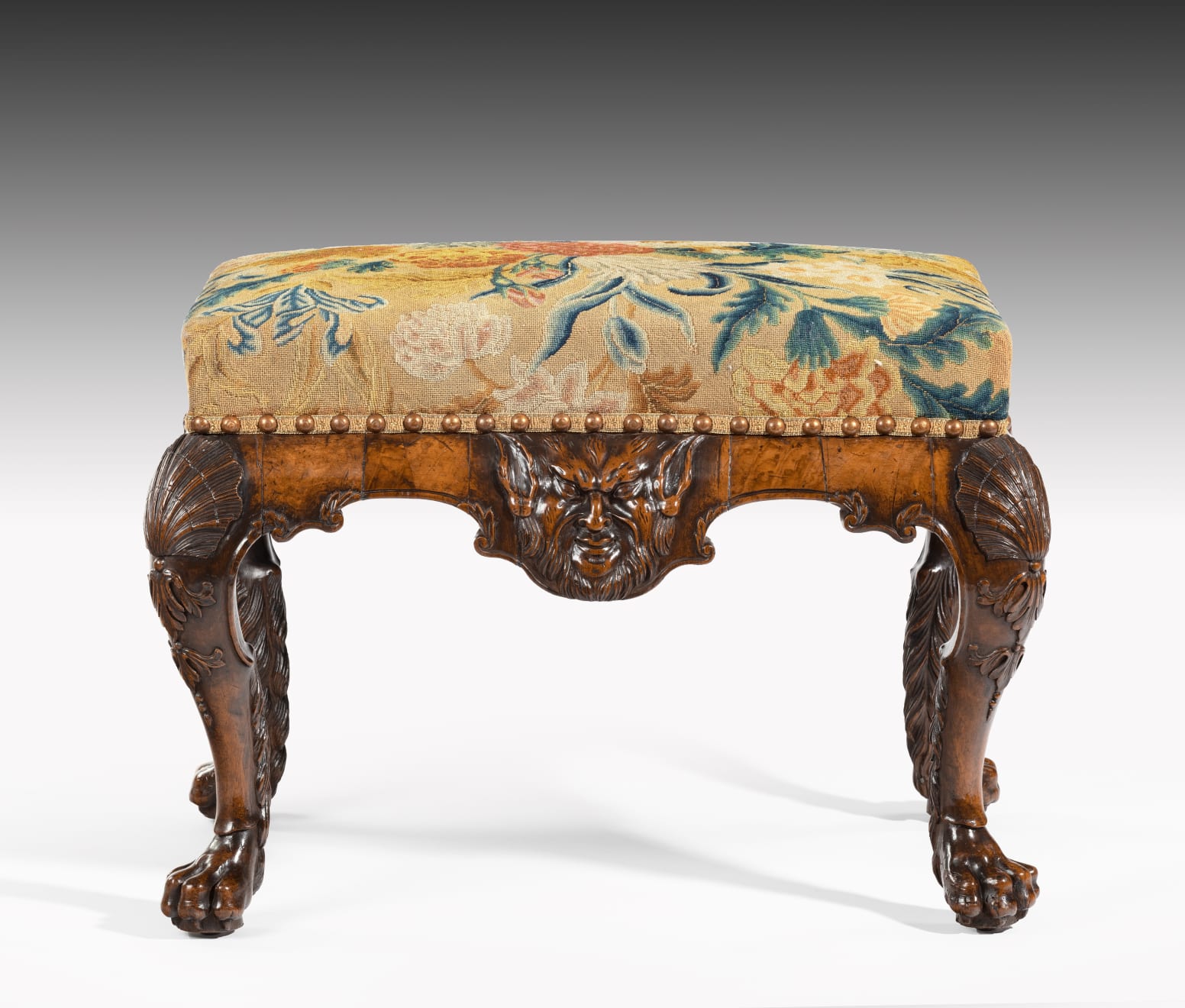George II Carved Walnut Stool
ENGLAND, circa 1730
45 x 65 x 49 cm
Further images
Provenance
Frank Partridge, between 1912-21. Donaldson Collection, circa 1924-27.Mr. C.B.O. Clarke. A.C.J. Wall Collection, Middleton Park, Oxon.
Literature
Illustrated in Ralph Edwards, ‘The Dictionary of English Furniture: Volume Three’ (Antique Collectors’ Club, 1983), p.176, fig. 45, where it is dated circa 1725 and is recorded as then forming part of the Donaldson Collection. ‘The Dictionary of English Furniture’ was first published in 1924-27.
With a petit-point floral needlework seat above a shaped and scrolled foliate-edged seat frame centred to each side with a carved faun or satyr mask, on scallop shell and bellflower pendant clasped scrolled cabriole legs carved with hock hair, terminating in lion’s paw feet. With an ivorine plaque which reads: ‘Frank Partridge, Works of Art, 26 King St., St. James’s and New York’, and also a printed paper label which reads: ‘The Property of C.B.O. Clarke’.
The design of this stool closely relates to a suite of Palladian side chairs and a matching settee executed after a design by William Kent (1685-1748). This comparable suite was originally supplied for Houghton Hall in Norfolk in circa 1731-35, where it has remained. These Houghton chairs, which are upholstered in green velvet, are each carved with a similar central faun/satyr mask at the centre of the front rail; and shells at the centre of the side rails. There are also similarities in the scrolled and exaggerated cabriole shape of the legs, the hock-carved hair, the distinctive serpentine form of the seat frames and the use of lion’s paw feet. The giltwood set were made for the Main State Apartment at Houghton Hall. One of these chairs is housed in Room 133, the Dr Susan Weber Gallery, at the Victoria and Albert Museum, W.25:1-2002, (http://collections.vam.ac.uk/item/O80353/chair-unknown/). A distinctive characteristic which both the Houghton suite and this stool have in common is their construction. They have beech rails – carving backed with pine and also pine blocking – which provides additional strengthening and explains their good overall condition.
An armchair, side chair, stool and settee from the suite in situ in the Green Drawing Room at Houghton Hall is illustrated in (Susan Weber (ed), ‘William Kent: Designing Georgian Britain’ (Yale University Press, New Haven and London, 2014), fig.18.4, p.473).
A.C.J. Wall was a successful business man born in Sutton Coldfield. He was a Birmingham industrialist who formed his significant collection of English 18th century furniture, ceramics, gold boxes, silver, painting, works of art and Chinese porcelain before and after the Second World War. Wall housed his collection at Middleton Park, in Oxfordshire, which was the home he bought in 1946.
Middleton Park: During the 17th century a castle, which had in fact been built in the reign of King Stephen (1135-1154) within the proximity of the current Middleton Park, was purchased by John Harman of Taynton. John Harman’s son then oversaw the construction of a mansion on the present day site of Middleton. Subsequently one of his descendants, Edmund Denton, sold the property in 1711 to the Honourable Henry Boyle, who was a cousin to the renowned Earl of Burlington.
After various other owners and architectural alterations, including a period during the mid-18th century when Middleton Park was under the tenure of William Villiers, the 3rd Earl of Jersey, the 19th century version of the house with its stone facade was ultimately demolished in the early 20th century. Following that, the celebrated architect Sir Edwin Lutyens was responsible for the building which still stands at Middleton today. Lutyens, who both designed and oversaw the construction of the current house during the period 1934-8, seemingly modelled it on great classical architecture of the 17th and 18th centuries, very much in keeping with the contents of its interior.










